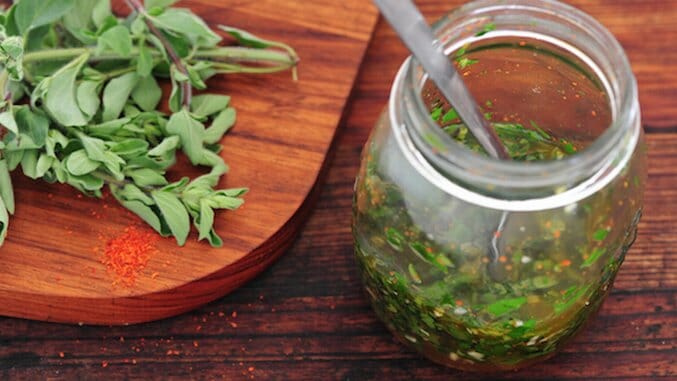In Defense of Chimichurri
Photo: jules/Flickr
One item on the menu catches my eye: flank steak with Argentinean chimichurri sauce and rosemary potatoes. It evokes the flavors of my home country. I’m happy that I can taste them here in Texas.
When I order the steak, our young server start to explain what chimichurri is: a sauce blah blah. “Oh, I know what it is, thanks.” Undeterred, he finishes his explanation. I tune out. The food arrives. The steak looks delicious and so do the potatoes. I look around for the chimichurri but I only see a creamy, Kryptonite green sauce on my steak. Is this it? Maybe I should have listened to our server. I try a little bit. It tastes of fresh herbs but chimichurri it is not. Not for the first time, my expectations as to flavors and techniques are clearly divorced from the reality on my plate.
I wasn’t kidding when I said I knew chimichurri. We come from the same country, we have a history together. Let’s see. Chimichurri is a very popular Argentinean sauce traditionally eaten with beef or grilled sausage. We sometimes affectionately call it “chimi” for short. It’s a fundamental component of the Argentinean Sunday asado, that coma-inducing grilled meat fest which takes the status of a religious ritual every Sunday. Men gather round the parrilla grill chatting and drinking beer while the meats slowly cook above the embers. Cooking on open flame is a foreign concept to us. Women set the table and make the salad. (Hmmm guys, we need to discuss gender equality.)
Some home cooks guard their secret recipe with their lives but are generous enough to make extra jars of chimi for their friends and family. However, most people buy it from the store. There are a few brands to choose from. I have brought back a bottle or two but I prefer to buy the dry mix. I rehydrate it with water and then add vinegar and oil and store it in the refrigerator.
At local parrillas, Argentinean steakhouses, waiters bring chimichurri and salsa criolla to the table together with the beef. Now, if it’s fresh sauce you’re after, salsa criolla is ideal. It consists of chopped fresh tomato, red bell pepper and green onions, salt, vinegar and oil.
The basic ingredients of traditional Argentinean chimichurri are parsley, either fresh or dried, dried oregano, minced garlic, red chile flakes, vinegar and oil. It can be more or less spicy depending on how much red chile is used. Unlike other Latin Americans, we don’t have asbestos mouths and therefore don’t like too much picante. A little warmth is just perfect.
-

-

-

-

-

-

-

-

-

-

-

-

-

-

-

-

-

-

-

-

-

-

-

-

-

-

-

-

-

-

-

-

-

-

-

-

-

-

-

-








































